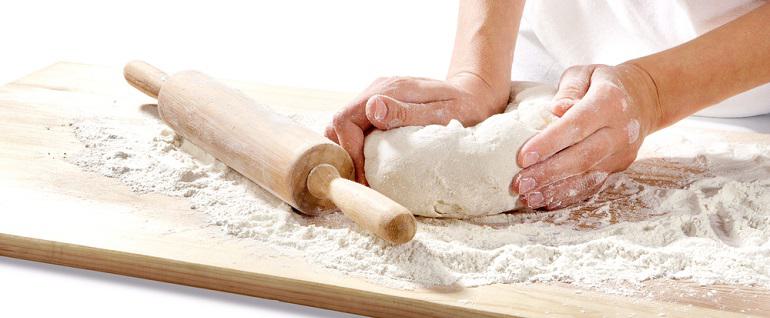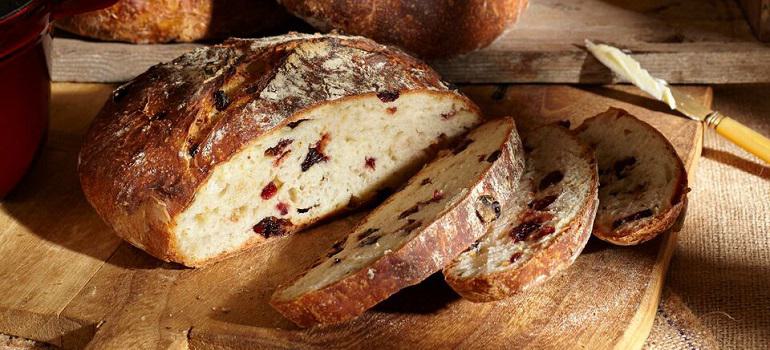


 Kneading dough is often the most challenging part of baking bread for novice bakers. Now, you may be wondering why we even have to knead dough in the first place. Kneading bread dough allows the protein molecules in the flour to form, creating healthy gluten strands. Gluten is what helps the mixture create gas, which helps it rise and build texture. When the dough has been adequately kneaded and the gluten has formed properly, it will take on several different characteristics. The dough will be easy to stretch, have an elastic-like feel and bounce back when touched.
Overworking or over-kneading dough is quite common when using a stand mixer. Because stand mixers produce faster results, it's easy to overdo it. The overworked dough will often feel tight and tough. This means that liquid molecules have been damaged and won't stretch properly, causing the bread to break and tear more easily. Conversely, a dough that is underworked will be harder to form into a ball shape. The underdeveloped gluten molecules will cause your dough to flop around and tear easily. While underworked dough can simply be fixed by a little more kneading, severely overworked dough cannot be fixed. Instead, the overworked dough will result in a hard loaf that will likely not be eaten. It's important not to overwork your dough and continually check for overworking throughout the kneading process.
For an easy-to-knead bread for novice bakers, start with this simple Gluten Free Soy Bread.
Kneading dough is often the most challenging part of baking bread for novice bakers. Now, you may be wondering why we even have to knead dough in the first place. Kneading bread dough allows the protein molecules in the flour to form, creating healthy gluten strands. Gluten is what helps the mixture create gas, which helps it rise and build texture. When the dough has been adequately kneaded and the gluten has formed properly, it will take on several different characteristics. The dough will be easy to stretch, have an elastic-like feel and bounce back when touched.
Overworking or over-kneading dough is quite common when using a stand mixer. Because stand mixers produce faster results, it's easy to overdo it. The overworked dough will often feel tight and tough. This means that liquid molecules have been damaged and won't stretch properly, causing the bread to break and tear more easily. Conversely, a dough that is underworked will be harder to form into a ball shape. The underdeveloped gluten molecules will cause your dough to flop around and tear easily. While underworked dough can simply be fixed by a little more kneading, severely overworked dough cannot be fixed. Instead, the overworked dough will result in a hard loaf that will likely not be eaten. It's important not to overwork your dough and continually check for overworking throughout the kneading process.
For an easy-to-knead bread for novice bakers, start with this simple Gluten Free Soy Bread.
 Worried about under-kneading your dough? As previously mentioned, because under-kneading dough can be fixed with just a bit more kneading, we wouldn't stress it. There are several ways that you can tell if your dough needs more kneading throughout the baking process.
A few signs of under-kneaded dough is a dough that is:
Worried about under-kneading your dough? As previously mentioned, because under-kneading dough can be fixed with just a bit more kneading, we wouldn't stress it. There are several ways that you can tell if your dough needs more kneading throughout the baking process.
A few signs of under-kneaded dough is a dough that is:
 While over-kneading dough is a common mistake when making bread, it's much less common if you're kneading by hand. This is because you'll likely tire yourself out long before it happens. Over-kneading happens most often when a hand mixer is involved. Because a hand mixer speeds up the kneading process, everything happens much more quicklyincluding over-kneading.
If you choose to knead your dough with a hand mixer, you must stop the mixer every few minutes and check in on your dough. This is especially true if you're new to baking bread and are still trying to learn the signs of over-kneaded vs. under-kneaded dough.
If your dough feels dense and tough to handle when you stop the mixer, it is a sign that it is becoming over-kneaded. Over-kneaded dough can become very hard to work with and produce a more flat and chewy bread. It's vital to stop mixing at the first signs of over-kneading, as a fully over-kneaded dough cannot be fixed. Over-kneaded dough will also tear more quickly, as the gluten strands in the dough have become so tight they easily break under pressure. If you believe that your dough is slightly over-kneaded, try allowing it to rise a little longer before shaping it into a loaf. While you can't fully undo the damage of over-kneaded dough, letting the dough rise for longer can help relax the gluten in the dough a bit.
So, you've found that your dough is over-kneaded. Now what? The over-kneaded dough can still be cooked. Just know that the result will be a bit different than you expected. Bread Loaves made with over-kneaded dough commonly end up with a hard crust and dry interior. Often upon cutting, slices will crumble. If your perfect bread loaf turns into a crumbly mess, don't worry. The overworked dough will work great when used as croutons or breadcrumbs.
For a simple way to tell if your dough has been over-kneaded, check for these signs of over-kneaded dough.
While over-kneading dough is a common mistake when making bread, it's much less common if you're kneading by hand. This is because you'll likely tire yourself out long before it happens. Over-kneading happens most often when a hand mixer is involved. Because a hand mixer speeds up the kneading process, everything happens much more quicklyincluding over-kneading.
If you choose to knead your dough with a hand mixer, you must stop the mixer every few minutes and check in on your dough. This is especially true if you're new to baking bread and are still trying to learn the signs of over-kneaded vs. under-kneaded dough.
If your dough feels dense and tough to handle when you stop the mixer, it is a sign that it is becoming over-kneaded. Over-kneaded dough can become very hard to work with and produce a more flat and chewy bread. It's vital to stop mixing at the first signs of over-kneading, as a fully over-kneaded dough cannot be fixed. Over-kneaded dough will also tear more quickly, as the gluten strands in the dough have become so tight they easily break under pressure. If you believe that your dough is slightly over-kneaded, try allowing it to rise a little longer before shaping it into a loaf. While you can't fully undo the damage of over-kneaded dough, letting the dough rise for longer can help relax the gluten in the dough a bit.
So, you've found that your dough is over-kneaded. Now what? The over-kneaded dough can still be cooked. Just know that the result will be a bit different than you expected. Bread Loaves made with over-kneaded dough commonly end up with a hard crust and dry interior. Often upon cutting, slices will crumble. If your perfect bread loaf turns into a crumbly mess, don't worry. The overworked dough will work great when used as croutons or breadcrumbs.
For a simple way to tell if your dough has been over-kneaded, check for these signs of over-kneaded dough.
 We've talked about over-kneading and under-kneading bread and how both are pretty easy to do. So how do you know when to stop kneading the dough to perfection? The point of kneading dough is to help strengthen the gluten in it. Gluten is what gives your bread; it's structure and texture. Gluten that is not strong enough results from under kneaded dough, whereas gluten that is too tight results from over kneaded dough. Whether you knead your dough by hand or use a mixer, you can look for sure signs to identify when your kneading process is done. Below we've outlined a few clues to help you know what to look for.
We've talked about over-kneading and under-kneading bread and how both are pretty easy to do. So how do you know when to stop kneading the dough to perfection? The point of kneading dough is to help strengthen the gluten in it. Gluten is what gives your bread; it's structure and texture. Gluten that is not strong enough results from under kneaded dough, whereas gluten that is too tight results from over kneaded dough. Whether you knead your dough by hand or use a mixer, you can look for sure signs to identify when your kneading process is done. Below we've outlined a few clues to help you know what to look for.